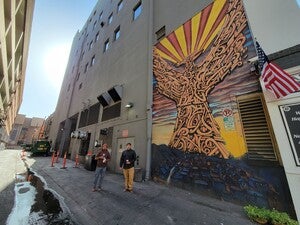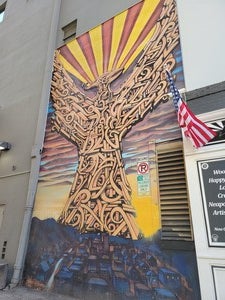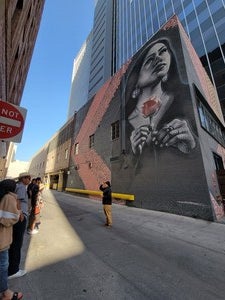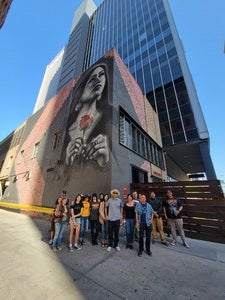
Wrangled with towers that stand like immense gray cactus stems towards a bright blue sky, Indigenous art rises up from the concrete jungle of Phoenix, Arizona in the form of murals. Murals are large. They take up space. Indigenous artist Thomas "Breeze" Marcus (O’odham, Ponca) demonstrates that some contemporary O'odham art is far too large to be contained and conceptualized in a museum. Rather, their art lives and breathes on the brick and steel walls of skyscrapers in major metropolitan areas, such as Phoenix.
On the morning of Saturday, April 15th, Breeze led a tour with the Labriola and ASU students and faculty in downtown Phoenix that encompassed two murals he helped paint and design. During middle school, Breeze engaged with the back roads and alleyways of downtown Phoenix, where he became familiar with his roots as an O'odham artist and the violence that came with practicing street art. His first mural, located north of Cartel Coffee- Downtown, reflected the iconic image of the Phoenix rising up from the ashes of this major metropolitan city. The Phoenix itself represents a rebirth of the O'odham people. Although stemming from an ancient city, they rise up from underground, transformed from ancient engineering mysteriously abandoned to a city built to assimilate tribal people. His mural shows that no concrete can contain our identities and histories as a people, and it is through these murals that one can visually see the impact Indigenous people continue to have on Phoenix.

Largely known for its "rebirth" from an ancient civilization into a major metropolitan city, Phoenix is indeed a renaissance. The O’otham people that have lived here since time immemorial, whose ancestors are known as "Hohokam", still influence the map of Phoenix. The O’otham's canal systems are still here to this day. Breeze informed us that "Hohokam" is a misinterpretation of the O’otham word "Huhugam", which roughly translates to "those who have passed on and are no longer living." Breeze's art is not only a conversation with the ancestors of the O’otham and our current relation to the world as contemporary Indigenous peoples, but is also an art form that belongs to the community. When he creates, Breeze gives it to the community and it no longer belongs to him. The community interprets what they want from the art, using it for storytelling, honoring their heritage, and uplifting their history.

This is particularly evident in the second mural Breeze took us to. On a brick wall there is a young O’otham woman holding a rose, looking east towards the rising sun. The sun is warm and ignites a red rose in flame against the cool gray hands of a young girl. This girl is a real figure from the community. She is adorned in contemporary clothing, her long black hair flows behind her, with beautiful basketry designs that frame her portrait. Breeze collaborated with a friend and they picked this image because they wanted to show that although our traditional clothing and values still influence us as Indigenous peoples, we are not just a people of the past: we are living, breathing, and thriving despite walls and barriers.
Who knew paint could be so powerful?
-Written by Yitazba Largo-Anderson
